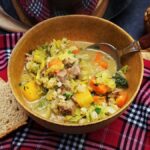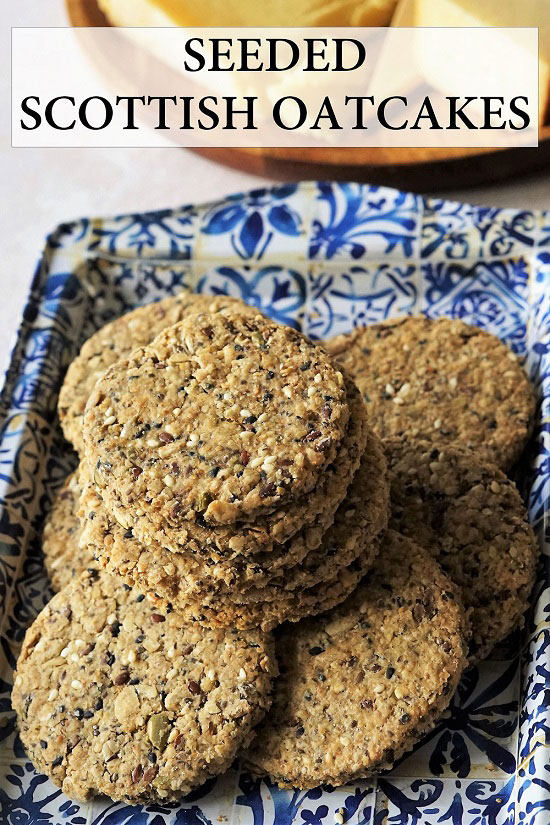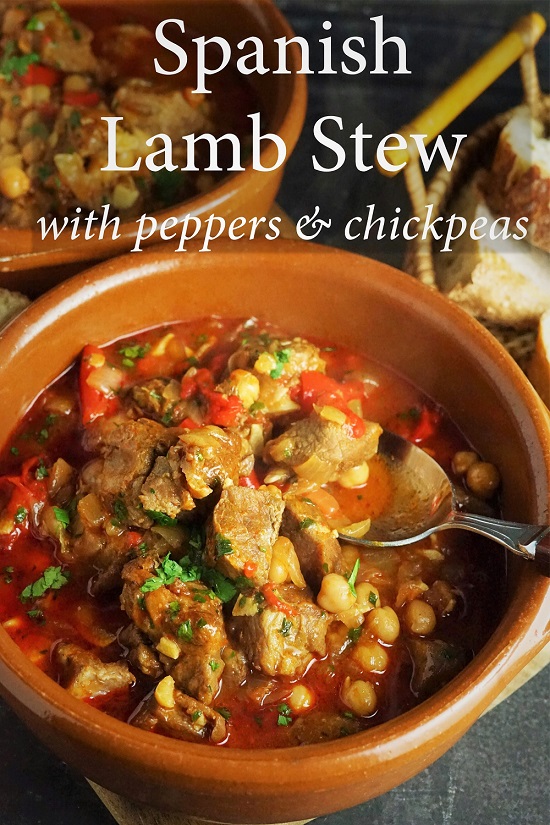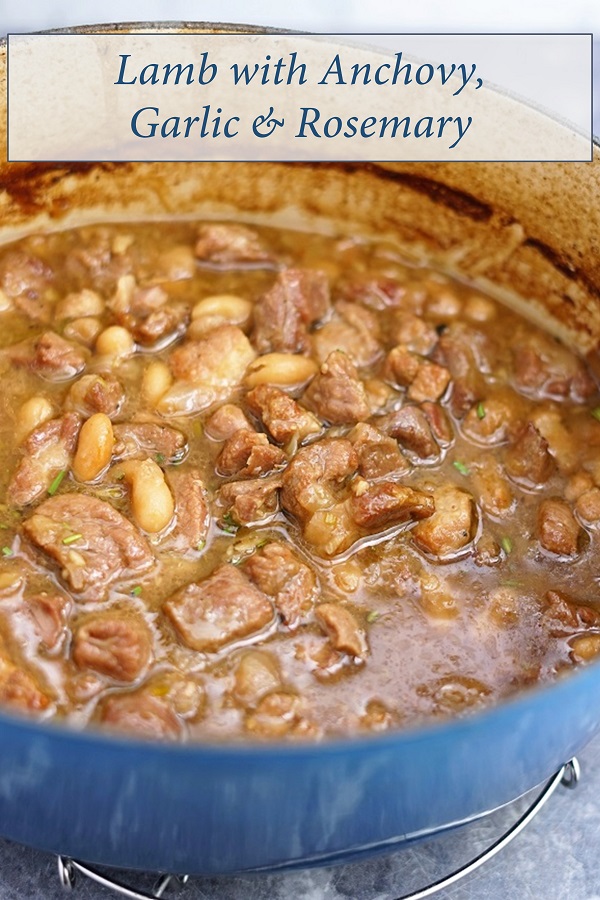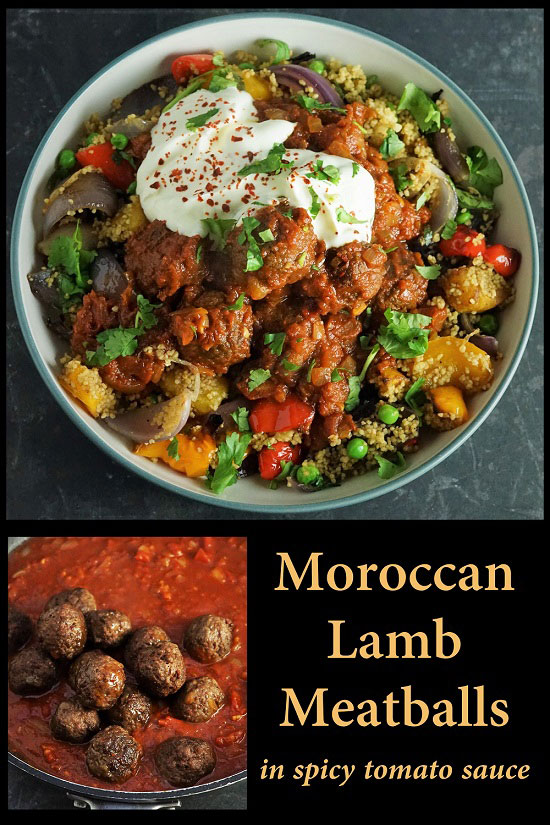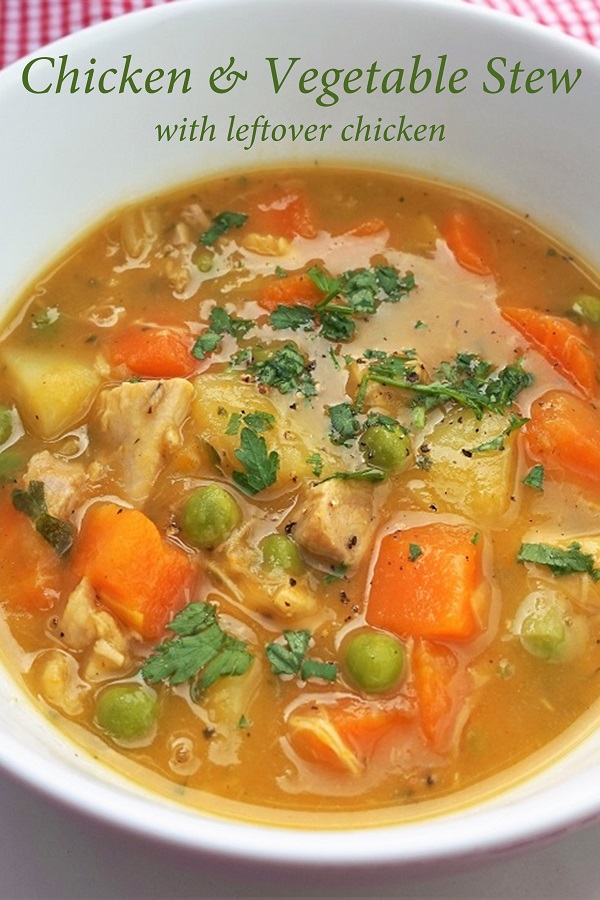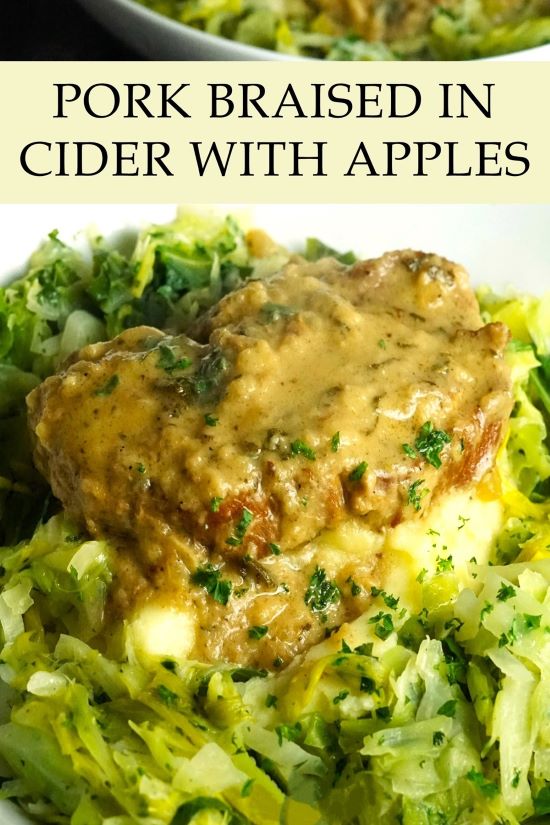Scotch Broth Recipe
Scotch Broth, also known as barley broth, is a one-pot meal in a bowl. With pearl barley, pulses, root vegetables, greens and lamb, my version is hearty and satisfying. It’s also very economical.
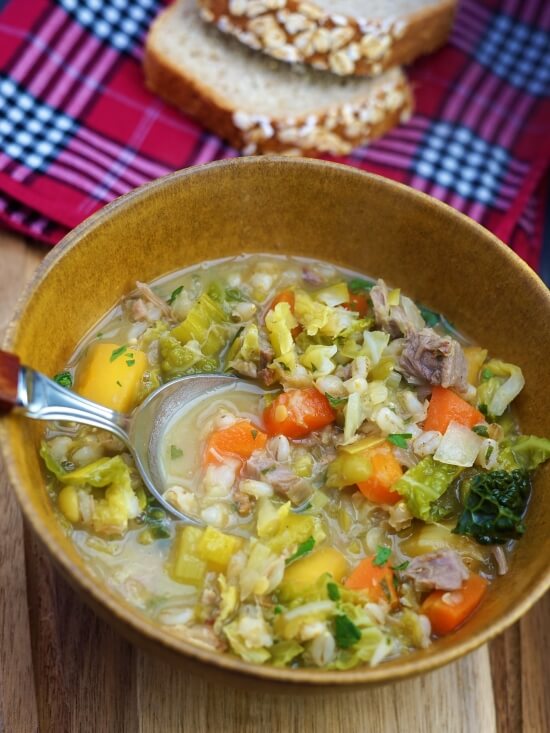
By combining a little leftover roast lamb with cheaper ingredients like green split peas and red split lentils, it can stretch to feed six people generously. In this recipe, I include the bones to get maximum flavour in the broth.
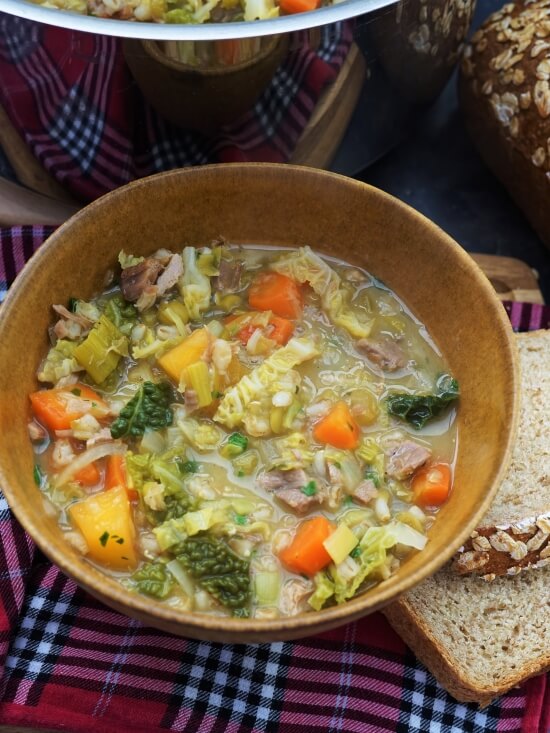
I like my Scotch Broth thick, but you can make it as a thinner soup with more stock. Either way, I think it’s a comforting, tasty bowlful.
Jump to Recipe
WHAT IS SCOTCH BROTH?
Although, these days, we think of a broth as being thin and stock-like, Scotch Broth is usually a hearty stew. While the meat, vegetables and pulses it contains can be adapted to what’s available, it always includes pearl barley. Hence its alternative name of barley broth. There are published recipes from almost three hundred years ago, but it’s thought that its origins probably go back much further. Perhaps even as far back as the ancient Picts.
In Traditional Scottish Cookery (1991), Theodora Fitzgibbons tells us that Scotch Broth had become widely known by the eighteenth century. According to Jane Grigson (The Observer Guide to British Cookery, 1984), while the rich included ‘pounds’ of meat in their broth, serving the cooking liquor as a soup, followed by a main course of the meat and vegetables, the poor ate theirs with just a little chopped meat in.
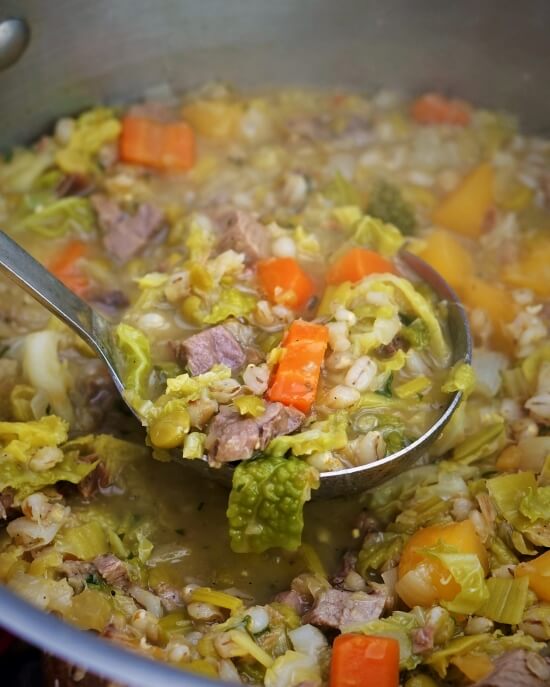
It’s in the tradition of economical, everyday food of the common people that my Scotch Broth sits. But don’t think that means unappetizingly frugal. Because it’s packed with good things and has excellent flavour. I use the bones from a roast leg of lamb to give rich flavour to the stock. In that stock I cook the rest of the ingredients for maximum taste: pearl barley, two types of pulses, root vegetables, and cabbage or kale. Just 200 – 225 grams of leftover roast lamb is enough to stretch the stew to feed six people generously. Even if you don’t have half a dozen mouths to feed, it’s still worth making a big batch. Because the flavours are even better when you eat it again the next day.
SCOTCH BROTH INGREDIENTS
As with virtually all versions of Scotch Broth, in mine the ingredients can be split into four categories.
Pearl Barley
Pearl barley is made from ears of barley that have been polished or ‘pearled’ to remove the outer layer of bran. Barley that has the bran still intact is called pot barley. Although the latter is more nutritious, it takes a lot longer to cook and you should get pearl barley for my recipe.
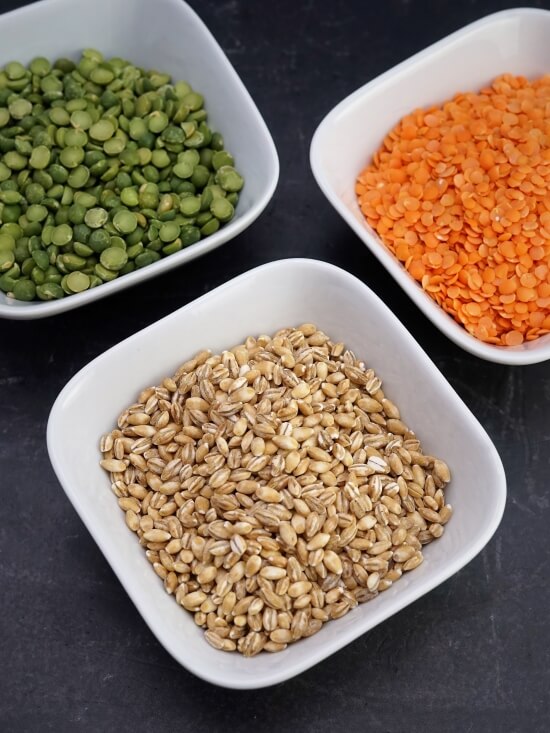
Once cooked, I find it has a pleasantly chewy texture. The taste is mild, but the grain will absorb all the delicious broth flavours.
Pulses
It’s possible to buy a broth mix that includes both the pearl barley and pulses such as dried whole peas, split peas and lentils. But I prefer to add my own choices and in the quantities I want. For me, that’s equal quantities of green split peas (you can substitute yellow) and red split lentils, plus slightly more barley.
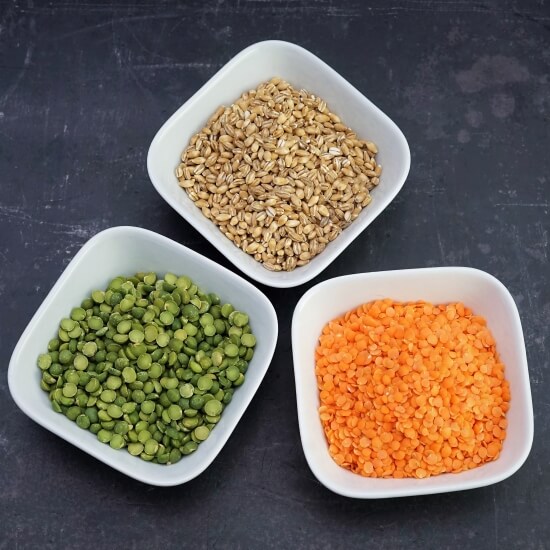
The split peas, but not the lentils or pearl barley, will need soaking overnight. If you want to include dried whole peas, you’ll need to soak these too. They’ll take approximately 15 minutes longer to cook than the split version.
Vegetables
Along with onions and/or leeks, Scotch or barley broth always contains either turnips or swede and often carrots too. In mine there’s onion, celery, leek, swede and carrot, but of course you can adapt it to what you have. Perhaps because the dish originated long before potatoes came to Scotland, they rarely seem to be included.
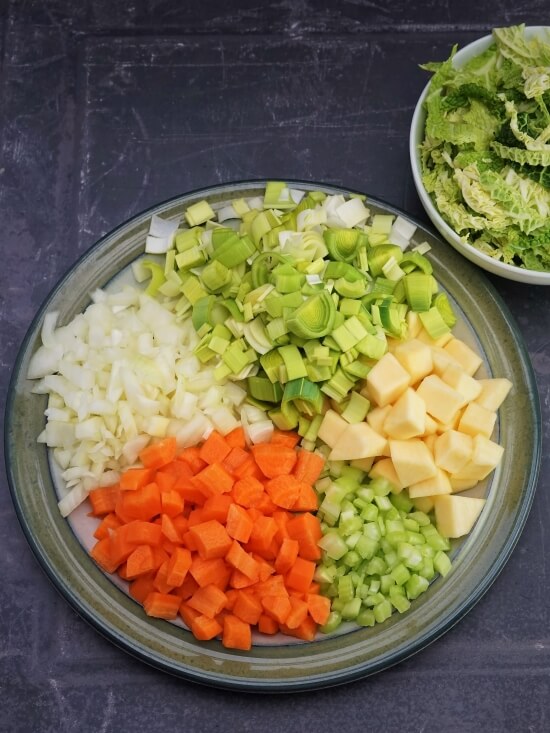
Greens are added near the end of cooking, usually cabbage or kale. But almost any greens will be fine. Here, I’ve included shredded Savoy cabbage.
Lamb/Hogget/Mutton
While a few versions of Scotch Broth suggest beef, I went with the more traditional lamb. Technically speaking, the lamb you see in this post is hogget. This is meat from an older sheep which has had longer to develop flavour. If you can get good quality mutton, which is even more mature, then I highly recommend that too. For simplicity, I’ll just refer to ‘lamb’ from now on.
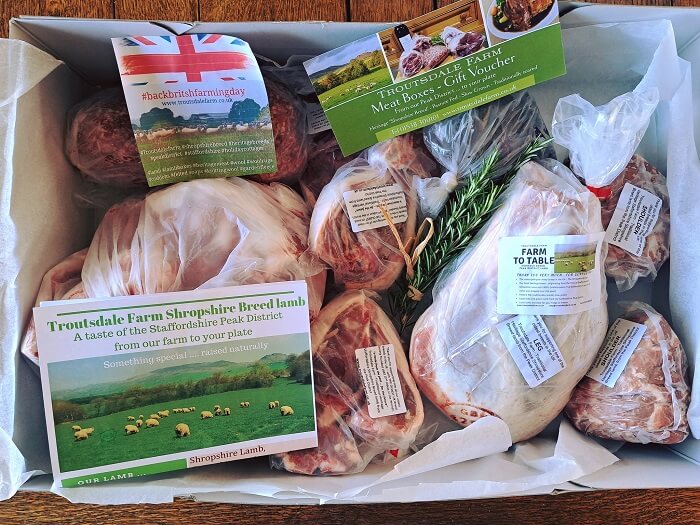
Lamb isn’t a cheap meat. But I buy almost all my lamb/hogget direct from the farm and that makes it much more affordable. The image above is of my most recent lamb box from Troutsdale Farm containing half a lamb, butchered to my requirements. This is a local family farm, and the meat is raised traditionally: slow grown and grass fed. It’s also absolutely delicious.
To make a big pot of Scotch Broth with at least six generous portions, I saved the bones from the roasted leg along with around 220 grams of the meat.
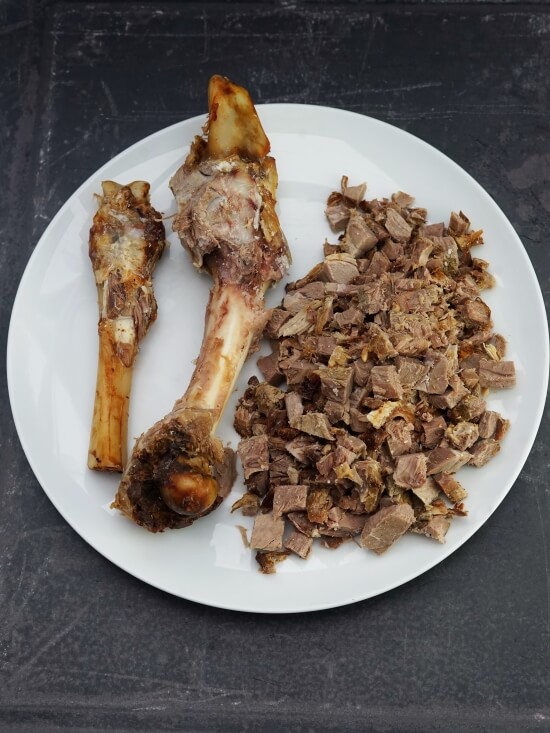
These were plenty to give excellent, meaty flavour to the stew. The remains of a roasted shoulder of lamb, including the bone, would also work. If you don’t have any bones, you could buy a commercially produced lamb stock.
EASY SCOTCH OR BARLEY BROTH
Scotch Broth isn’t a quick dish to make if you want the best flavour. But that doesn’t mean it’s difficult or needs a lot of hands-on work. You just need to allow time to first flavour the liquid then cook the pulses and barley followed by the vegetables.
If you’re ready to cook, Jump to Recipe at the end of this post. Or read on for tips and step-by-step images.
I start off by putting the bones into a large saucepan along with some light stock (from chicken stock cubes in my case). At a pinch, you could use just water, but you’d need to cook the bones for longer, or have a lot of bones. I wanted a thick broth so added 2.25 litres of stock. Add up to 3 litres for a thinner, more soup-like result, or wait until the end of the cooking and dilute as necessary.
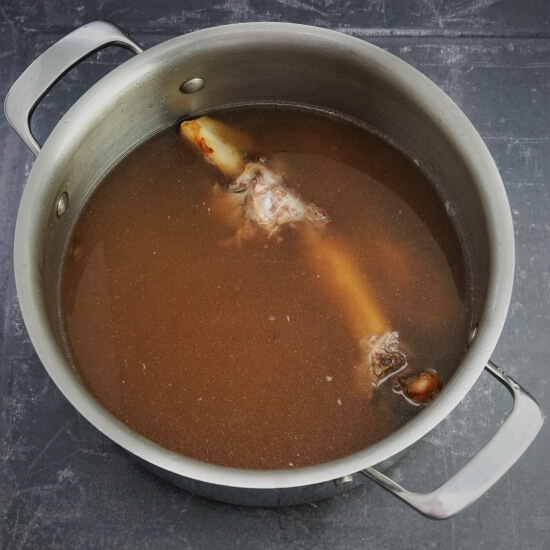
Now let the bones and stock simmer away for 30 minutes. Next, in go the onion, celery, pearl barley and pulses, simmering for another 30 minutes. During this stage, I take the pot off the heat a few times and skim any impurities from the surface. After this time, the pulses and barley should be well on their way to being cooked. I found the broth already had a good flavour.
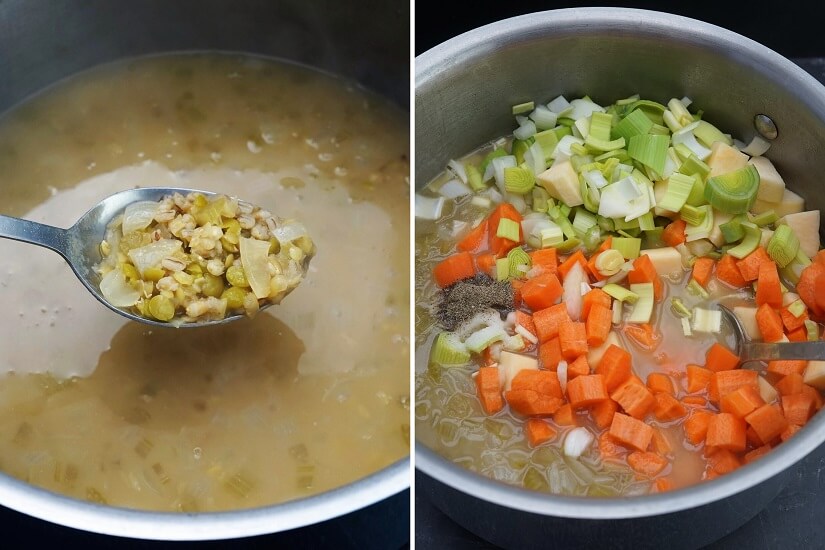
The bones can be discarded now, and the chunks of swede, carrot, and leek put in. I also season with salt and pepper. Adding salt before this point can toughen pulses so they take longer to cook.
Another 10 minutes simmering and I stirred in the chopped meat, shredded cabbage and some parsley.
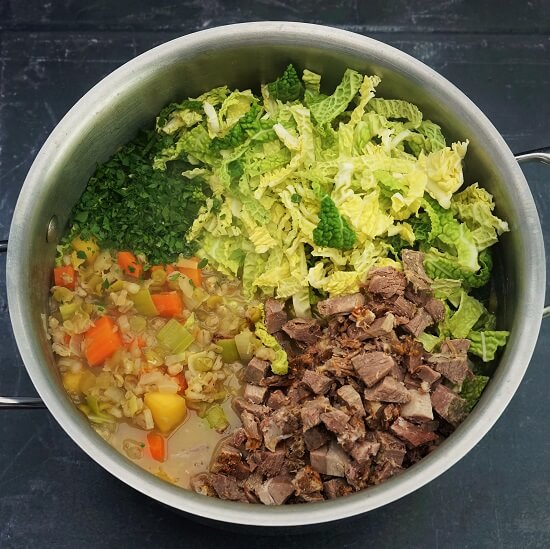
A final simmer of 10 – 15 minutes to finish cooking the vegetables and meld the flavours, a quick seasoning check, and your Scotch Broth is ready.
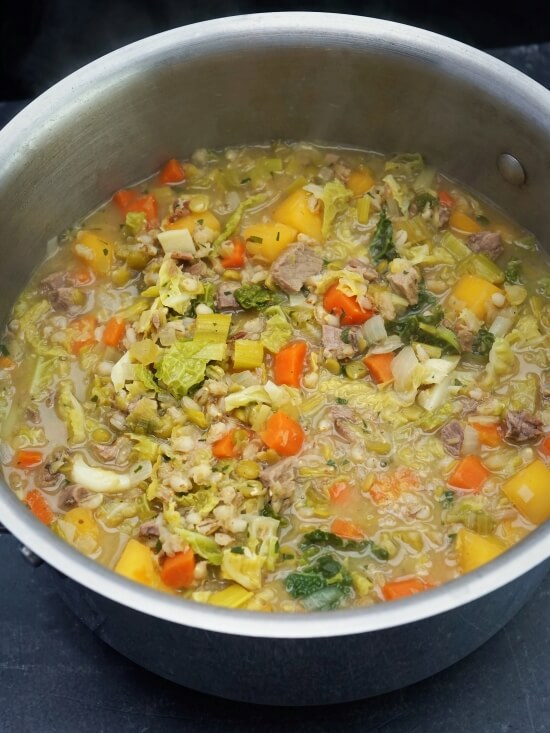
WHO KNEW SCOTCH BROTH WAS SO GOOD?
I must admit, I was surprised at just how good this dish tasted. The lamb bones had given so much flavour to the rest of the ingredients, even though they’d only been in the broth for an hour. Vegetables were tender without being mushy. The pearl barley had plumped up, absorbing the lip-smacking taste of the stock, but still had satisfying chewy texture.

While the red split lentils had broken down and helped naturally thicken the broth, the green split peas remained largely intact to be spooned up in hearty mouthfuls. And those little nuggets of tender lamb added even more pleasure. Although Scotch Broth is a complete one-pot meal, I couldn’t resist serving it with some freshly baked Oatmeal Bread to clear every scrap from my bowl.
I’d started out thinking this broth with its possibly ancient roots might be a little frugal for my taste. Worthy perhaps, with its vegetables, pulses and grains. But would it be enjoyable? To my delight, I found that I loved it. And the next day it tasted even better. The barley had soaked up more of the broth, so I just added a splash of water when reheating on the stove. I’ve also got some stored in the freezer for a quick, hearty meal another day.
HAVE YOU MADE MY SCOTCH OR BARLEY BROTH? LEAVE A COMMENT & RATE THE RECIPE
Scotch Broth
With pulses, pearl barley, lots of vegetables plus meat, Scotch Broth is a hearty meal in a bowl that tastes even better the next day.
It's also an economical way to stretch a small amount of leftover roast lamb, including the bones to flavour the stock.
If you don't have any lamb bones, use a commercial lamb stock, bring to a simmer and proceed from step 2.
Ingredients
- 75 g green split peas see Recipe Note #1
- 2.25 - 3 litres light lamb or chicken stock see Recipe Note #2
- 1 lamb bone left over from a roast leg or shoulder
- 2 medium onions roughly chopped
- 2 stalks celery roughly chopped
- 100 g pearl barley rinsed
- 75 g red split lentils rinsed
- salt and pepper
- 200 g carrot diced
- 200 g swede or turnip diced
- 1 leek roughly chopped
- 150 g cabbage or kale roughly chopped or shredded
- 200 - 250 g leftover roast lamb roughly chopped
- 2 tbsp chopped parsley
Instructions
The night before making the broth
-
Rinse the green split peas in a sieve then put into a bowl. Cover with cold water to a depth at least twice that of the peas.
Leave to soak overnight then drain and refresh under cold running water.
Making the broth
-
Put the stock and lamb bone into a large saucepan, put on a lid and bring to a boil.
Turn the heat down to a simmer and cook for 30 minutes.
-
Add to the pot the onion, celery, the soaked and drained green split peas, the pearl barley and the red split lentils. Bring back up to the boil then simmer for 30 minutes.
During this stage take off the heat two or three times while you skim off and discard any impurities from the surface.
-
Take out the bones and discard them.
Add 1 tsp salt and ¼ tsp pepper plus the prepared carrot, swede and leeks. Simmer with a lid on until the pulses, barley and vegetables are almost tender (approx. 10 minutes).
-
Stir in the shredded greens, the meat, and half the parsley.
Simmer for 10 minutes or until the vegetables are done to your liking.
-
Check the seasoning again and serve with the remaining parsley sprinkled over.
Leftovers can be stored in the fridge for 2 - 3 days or frozen. The barley will continue to soak up liquid, so add a splash or two of water when reheating on the stove or in a microwave.
Recipe Notes
#1 Green Split Peas. Can be substituted with yellow split peas. Whole dried green peas can also be used, although they may need an extra 15 minutes.
#2 Stock. I've given a wide margin for how much stock to use. I like a thick Scotch Broth so use the smaller amount. For a thinner version, either include more stock at the beginning or adjust at the stage of adding the meat.
RELATED RECIPES

